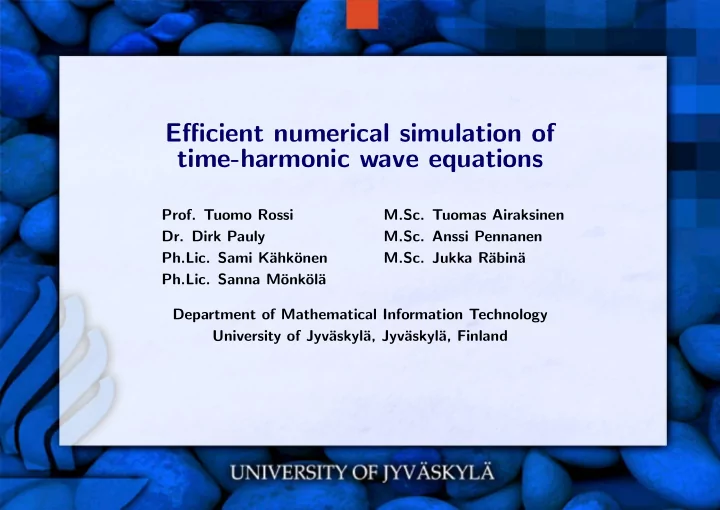

Efficient numerical simulation of time-harmonic wave equations Prof. Tuomo Rossi M.Sc. Tuomas Airaksinen Dr. Dirk Pauly M.Sc. Anssi Pennanen Ph.Lic. Sami K¨ ahk¨ onen M.Sc. Jukka R¨ abin¨ a Ph.Lic. Sanna M¨ onk¨ ol¨ a Department of Mathematical Information Technology University of Jyv¨ askyl¨ a, Jyv¨ askyl¨ a, Finland
Collaboration The research group has active collaboration with, e.g., • Dr. Erkki Heikkola (Numerola Oy) • Dr. Jari Toivanen (University of Stanford) • Prof. Roland Glowinski (University of Houston) • Prof. Norbert Weck, Prof. Karl Josef Witsch, Prof. Axel Klawonn, Dr. Oliver Rheinbach (University of Duisburg-Essen)
On-going research project with Department of Physics, University of Jyv¨ askyl¨ a: efficient simulation methods for modeling the fluid flow in porous materials. • K. Mattila, J. Hyv¨ aluoma, T. Rossi, M. Aspn¨ as, J. Westerholm, An efficient swap algorithm for the lattice Boltzmann method, Computer Physics Communications (2007). • K. Mattila, J. Hyv¨ aluoma, J. Timonen, T. Rossi, Comparison of implementations of the lattice-Boltzmann method, Computers & Mathematics with Applications (2008).
Contents Physical phenomena Mathematical model (partial differential equations) Discretization methods Efficient solvers Simulation results
Applications on various fields of science and engineering • Fluid dynamics: computational acous- tics, echo sounding, • Elastodynamics: deformation of elastic structures, seismic waves, • Electromagnetics: antenna applica- tions, • Medical and biological systems: mod- eling the structure of human tissue (medical imaging), cochlea in the in- ner ear.
Example of coupled time-harmonic wave equations: fluid-structure interaction Structure domain Ω s Fluid domain Ω f Ω s Ω f Γ − ω 2 − ω 2 ρ s u s − ∇ · σ ( u s ) = g s in Ω s , c 2 p − ∇ 2 p = g f in Ω f , ∂p + ω 2 ρ f u s · n s = 0 on Γ , ∂ n f σ ( u s ) n s − p n f = 0 on Γ .
Numerical simulation • Simulation tools are used to avoid dangerous, expensive and time-consuming ex- periments. • Computer simulation is an efficient tool in testing and optimizing of model param- eters. • The design process can be dramatically improved and the development cycle short- ened with computer aided modeling. • Solving problems arising from real life applications demands a considerable amount of time and memory – need to use efficient methods, – utilization of modern parallel computing platforms (Playstation 3 CELL-processors, Nvidia CUDA graphics processors).
Discretization methods • Traditionally: low-order Finite Element Method (FEM), – Especially for heterogeneous materials, sufficient accuracy requires dense dis- cretization = ⇒ large-scale systems to be solved. – Solutions with high frequency suffer from numerical dispersion. – For time-harmonic wave equations it is challenging to construct efficient iterative solution techniques. • Novel approaches: – element-based methods with higher-order polynomial basis, e.g., Spectral Element Method (SEM), – Discrete Exterior Calculus (DEC).
Efficient solution techniques • Fictitious domain, – The computational domain is embedded into a larger and simpler domain. – a tetrahedral finite element mesh, which is locally adapted to the bound- ary of the obstacle D [B¨ orgers -90]. – linear finite elements with mass lump- ing.
Wave scattering by a submarine, 200 wavelenghts per diameter, 20 nodes per wavelenght.
• Domain decomposition, – The computational domain is divided into subdomains. – Instead of solving the whole PDE-system, the problems in the subdomains are solved separately. – The sequence of the subproblems converge to the solution of the original prob- lem.
• Multigrid preconditioners – Shifted-Laplacian operator (damped Helmholtz operator), ρ ( x ) ∇ − ( β 1 + β 2 i ) k ( x ) 2 1 B SL = −∇ · ρ ( x ) , as a preconditioner. Vibrations in a crankshaft
• Exact controllability – Searching for the periodic solution of the time-dependent wave equations. – Initial conditions e 0 and e 1 are the control variables, and we minimize � T � ∂ Y N � ∂ Y N � 1 + 1 � T K Y N − e 0 Y N − e 0 � � � J ( e 0 , e 1 , Y ( e 0 , e 1 )) = − e 1 M − e 1 . 2 2 ∂t ∂t – Y contains the nodal values and solves the system of wave equations in [0 , T ] .
Recent/selected journal publications • T. Airaksinen, E. Heikkola, A. Pennanen, J. Toivanen, An algebraic multigrid based shifted-Laplacian preconditioner for the Helmholtz equation, Journal of Computational Physics (2007). • T. Airaksinen, E. Heikkola, J. Toivanen, Active noise control in a stochastic domain based on a finite element model, Journal of Sound and Vibration (submitted). • T. Airaksinen, A. Pennanen, J. Toivanen, A damping preconditioner for time-harmonic wave equations in fluid and elastic material, Journal of Computational Physics (2009). • T. Airaksinen, S. M¨ onk¨ ol¨ a, Comparison between shifted-Laplacian preconditioning and controllability method for com- putational acoustics, Journal of Computational and Applied Mathematics (to appear). • R. Glowinski, T. Rossi, A mixed formulation and exact controllability approach for the computation of the periodic solutions of the scalar wave equation. (I) Controllability problem formulation and related iterative solution’, C. R. Math. Acad. Sci. Paris, (2006). • E. Heikkola, S. M¨ onk¨ ol¨ a, A. Pennanen, T. Rossi, Controllability method for acoustic scattering with spectral elements, Journal of Computational and Applied Mathematics (2007). • E. Heikkola, S. M¨ onk¨ ol¨ a, A. Pennanen, T. Rossi, Controllability method for the Helmholtz equation with higher order discretizations, Journal of Computational Physics (2007). • S. M¨ onk¨ ol¨ a, Time-harmonic solution for acousto-elastic interaction with controllability and spectral elements, Journal of Computational and Applied Mathematics, (to appear). • D. Pauly, Generalized Electro-Magneto Statics in Nonsmooth Exterior Domains, Analysis, (2007). • D. Pauly, Complete Low Frequency Asymptotics for Time-Harmonic Generalized Maxwell Equations in Nonsmooth Exterior Domains, Asymptotic Analysis, (2008).
Recommend
More recommend